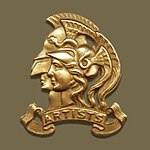Artists' Rifles
| The Artists Rifles | |
|---|---|

Cap badge of The Artists Rifles
|
|
| Active | 1859–1945 1947–present |
| Country |
|
| Branch | The Army Reserve |
| Type | Infantry Officer Training (prior to 1947) Long-range reconnaissance patrol |
| Role | Reconnaissance and long range patrols (current) |
| Part of | 1st Intelligence, Surveillance and Reconnaissance Brigade |
| Engagements | Boer War, World War I |
| Decorations | 8 VCs, 56 DSOs, 893 MCs, 26 DFCs, 15 AFCs, 6 DCMs, 15 MMs, 14 MSMs, 564 MIDs (World War I) |
| Battle honours |
Boer War: South Africa 1900–01. |
| Commanders | |
| Notable commanders |
Henry Wyndham Phillips and Frederic Leighton |
Boer War: South Africa 1900–01.
The Artists Rifles is a regiment of the British Army Reserve. Raised in London in 1859 as a volunteer light infantry unit, the regiment saw active service during the Second Boer War and World War I, earning a number of battle honours. It did not serve outside Britain during World War II, as it was used as an officer training unit at that time. The regiment was disbanded in 1945 but in 1947, it was re-established to resurrect the Special Air Service Regiment. Today, the full title of the Regiment is 21 Special Air Service Regiment (Artists) (Reserve) (21 SAS(R)) and with 23 Special Air Service Regiment (Reserve) (23 SAS(R)), it forms the Special Air Service (Reserve) (SAS(R)).
The regiment was formed in 1859, part of the widespread volunteer movement which developed in the face of potential French invasion after Felice Orsini's attack on Napoleon III was linked to Britain. The group was organised in London by Edward Sterling, an art student, and comprised various professional painters, musicians, actors, architects and others involved in creative endeavours; a profile it strove to maintain for some years. It was established on 28 February 1860 as the 38th Middlesex (Artists') Rifle Volunteer Corps, with headquarters at Burlington House. Its first commanders were the painters Henry Wyndham Phillips and Frederic Leighton. The unit's badge, designed by J. W. Wyon, shows the heads of the Roman gods Mars and Minerva in profile. Until 1914 the regimental full dress uniform was light grey with white facings, silver buttons and braid. This distinctive uniform dated from the regiment's foundation as a volunteer unit. After World War I standard khaki was the normal dress.
...
Wikipedia
